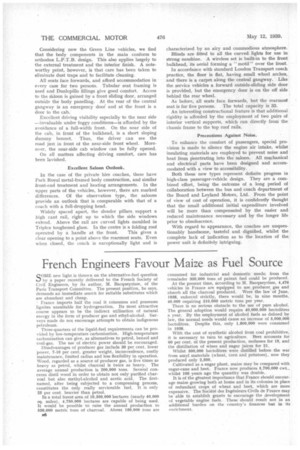French Engineers Favour Maize as Fuel Source
Page 40

If you've noticed an error in this article please click here to report it so we can fix it.
SOME new light is thrown on the alternative-fuel question by a paper recently delivered to the French Society of Civil Engineers, by its author, M. Bacqueyrisse, of the Paris Transport Committee. The present position, he says, demands an immediate search for suitable substitutes which are abundant and cheap.
• France imports half the coal it consumes and possesses lignites unsuitable for hydrogenation. Its most attractive course appears to be the indirect utilization of natural energy in the form of producer gas and ethyl-alcohol. Surveys made do not encourage attempts to obtain indigenous petroleum.
Three-quarters of the liquid-fuel requirements can be provided by low-temperature carbonization. High-temperature carbonization can give, as alternatives to petrol, benzol and coal-gas. The use of electric power should be encouraged.
Disadvantages of producer gas include 30 per cent. lower 'power, 7-10 per cent, greater weight, inconvenience, costly maintenance, limited radius and less flexibility in operation. Wood, regarded as a source of producer gas, is five times as heavy as petrol, whilst charcoal is twice as heavy. The average annual production is 200,000 tons. Several concerns distil wood in order to obtain not only purified charcoal but also methyl-alcohol and acetic acid. The firstnamed, after being subjected to a compressing process, constitutes the only really serviceable fuel. It is only 25 per cent, heavier than petrol.
In a total forest area of 10,350,000 hectares (nearly 90,000 sq. miles), 4.750,000 hectares are capable of being used. It would be possible to raise the annual production to 550,000 metric tons of charcoal. About 150,000 tons are
consumed for industrial and domestic needs; from the remainder 350,000 tons of patent fuel could be produced.
At the present time, according to M. Bacqueyrisse, 4,476 vehicles in France are equipped to use producer, gas and absorb all the charcoal produced. Were the law of June, 1938, enforced strictly, there would be, in nine months, 40,000 requiring 310,000 metric tons per year.
There is no serious obstacle to the use of pure alcohol. The general adoption would require 40,000.000 hectolitres a year. By the employment of alcohol fuels as defined by law, the normal needs would cause an increase of 5,000,000 hectolitres. Despite this, only 1,800,000 were consumed in 1938.
With the cost of synthetic alcohol from coal prohibitive, it is necessary to turn to agriculture. Beet accounts for 60 per cent, of the present production, molasses for 19, and the distillation of wines and sugar juices for 21.
Whilst 500,000 hectolitres were distilled before the war from amyl materials (wheat, corn and potatoes), now they produced only 2,500.
Cultivated as a sugar plant, maize may be compared with sugar-cane and beet. France now produces 5,700,000 cwt., whilst 100 years ago the quantity was double.
It is of the greatest importance that France should encourage maize growing both at home and in its colonies in place of redundant crops of wheat and beet, which are more expensive. The Societe des Ingenieurs Civils de France may be able to establish grants to encourage the development of vegetable engine fuels. These should result not in an additional burden on the country's finances but in its enrichment.














































































